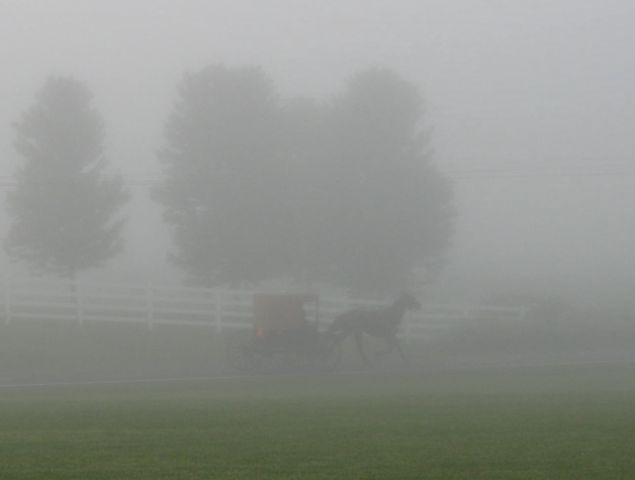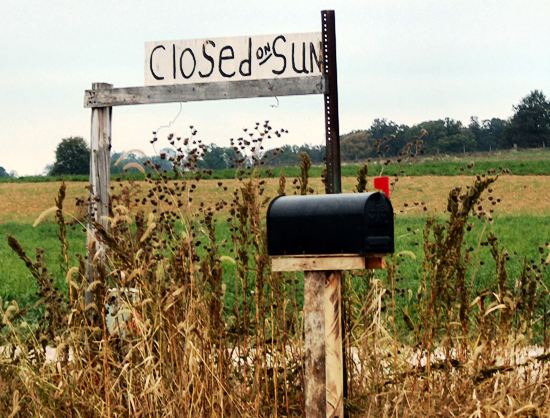Blue doors, brown buggies: The Amish of New Wilmington, PA

‘In 1847, nine families, all Bylers, moved to Lawrence, PA, they were: Solomon, Christian, Yost, Daniel, Noah, John, Reuben, Rudy, and Eli, and were among the first Amish in that section.
In year 1880 bishop Crist (Christian) Byler walked from Lawrence County to the Valley. He traveled a distance of 250 miles in 4 days at the age of 68. He also made the trip once since. There were quite a few who walked out and back after the Lawrence County Settlement established allowing 5 or 6 days for the journey.’
The Valley that Eli J. Byler writes of here is the Kishacoquillas Valley, also known as the ‘Big Valley’, of Mifflin County, PA, home to Nebraska Amish, Renno Amish, Byler Amish and a host of higher-order Amish and Mennonite groups.
The Amish surrounding New Wilmington, a quaint college town in northern Lawrence County, about 60 miles north of Pittsburgh, have a few customs not commonly seen elsewhere in Amish America. One is their use of reddish-brown-topped buggies, which Byler describes as ‘yellow-top’. He writes that the Byler Church of Mifflin County also uses yellow-top carriages, as do a few other settlements that have split off from the New Wilmington group.
The Amish here seem to be pretty big on the color blue. Nearly every house-door is painted a light sky-blue. I also noticed stairs leading to a front porch, and the door of a milk house painted in the same shade. A woman I asked ascribed this practice to tradition.
The New Wilmington Amish tend to stick with shades of blue when it comes to their shirts and dresses as well–navy, sky, royal, turquoise. I got to visit on wash day.
This community is perhaps the eleventh or twelfth largest of all Amish settlements. The 2003 Church Directory gives the following statistics:
Families: 439 more or less
Widowers: 6
Widows: 28
Children: 1220
Total Population: around 1693 19 couples moved out
People I spoke with in this settlement mentioned trips to, family in, and business connections with the Lancaster settlement. I didn’t have a chance to ask, but there’s a decent chance they’d be back-and-forth with Amish in Mifflin County as well. Farming and sawmill work seem to be two of the most common occupations, as well as other types of woodworking and carpentry.
(Quote Source: Pennsylvania Amish Directory of the Lawrence County Settlement, 2003.)










That was very interesting. i love the blue doors.
Question: Do you ask permission before you take your photos? How do you handle that? My apologies if you’ve addressed this question elsewhere.
Photos of Amish-distance shot vs. close-up
Good question, John–if it’s a distance shot, no. If it is up close, I usually do. For example I asked for permission on the close-up of the door in this post. Pictures inside of barns as well, and a number of others.
I generally try not to be too hung up on it as long as I don’t show their faces, though in any case many don’t care since for many the issue tends to be more about vanity–if they did not pose for it, it’s a different story than if they sat there with a smile. Though I know some Amish that don’t really even care about that, and will pose. A lot of variety on the issue, just like all the rest of it!
And thanks michelle. The blue theme is great.
I am new to researching Amish. I heard the original blue door was they painted the whole door blue when someone was available for courtship. has anyone else hear that
I really enjoy reading your blog. Nice to see the New Wilmington community mentioned. I live near Pittsburgh and visit the New Wimington and Smicksburg areas fairly often to buy produce, baked goods, order furniture or whatever. Charming, picturesque and friendly.
Do the amish have shops to buy stuff there? I know smicksburg does. I love going there for a nice drive. I love about 40 mins away. I’d love to live where the amish are.
Thanks Bill! And thanks a ton for reading, I do appreciate it. I only was able to be at New Wilmington for two days, but I really like that community. What is Smicksburg like?
The Smicksburg settlement is about the same size or now maybe bigger than the New Wilmington settlement. It is more rural or “off the beaten path”, so to speak, than the New Wilmington settlement and has spread over a wider geographic area. The town of Smicksburg itself is pretty small and has been commercialized by the “English”, but remains fairly unobtrusive because of its small size. The Amish drive black Ohio style buggies with slow moving vehicle signs without reflective tape, though I have seen reflective tape on buggies further to the NE and NW in the Punxatawney area.
There are plenty of back roads to explore and road signs advertising goods for sale. A pleasant way to spend a day away from it all.
Interesting, Bill, I had read that they were of a bit stricter Ordnung than, say Lancaster County. There are not a lot of Ohio style buggies in PA; this if I’m not mistaken must be the largest group that would use that type in the state.
One of my favorite books is Stephen Scott’s Plain Buggies. You can tell he put a lot of effort into it. Great guide.
I’m 12 miles east of New Wilmington.
I have also heard the local Amish say that the reason they paint their doors blue is simple custom.
That’s the truth, but I’m quite sure there is much more to it than that.
I believe the blue door “tradition” can be traced to old Pennsylvania German superstitions that were heavily influenced by the Scots Irish of Pennsylvania.
According to such belief, a blue door or gate is an effective talisman against evil – much like a horseshoe hung above the door.
Many folk magic traditions and customs maintain that a witch cannot cross a blue threshold.
Thankyou for addressing the blue door thing. I live very near New Wilmington, and 3 of my children go to Westminster College there. I truly beleived that there was something more to that than they like the color blue, or that color was “on sale”.
One other question that I have is: Are all the amish street ponies, bays in color, in other communities as well? have notice that the draft horses are most any color, but all of the buggy ponies are bay.
bay horses
I live just 5 miles from New Wilmington in New Castle, and although I cannot give a factual answer to the “are all street horses bay,” I can say from personal observation that they are not. There are many dark brown and black ones as well. Just 2 days ago I took an up close photo of a pure black horse as it passed by where I was taking pictures on Rt. 208 between New Wilmington and Volant. I do know that many Amish here purchase retired race horses.
Laura, I wish I could answer your question, but I am just not too up-to-speed on the equestrian world! Hope you are able to find your answer somewhere.
Hi,my husband is from New Castle, PA, whre several Amish work.When we went driving thru nearby Amish countryside, he said the blue doors meant they had an marriageable daughter. Is that misinformation or was that once the case?
Blue gate legend among Pennsylvania Amish
Hi Ginni, that sounds like a variation on the old ‘blue gate’ myth which basically said the same thing, but referencing a blue gate, and I believe originating in the Lancaster settlement, though don’t quote me. The blue gate idea is legend, not something you’ll see in reality.
And since basically every single Amish home in the New Wilmington settlement (which I think you may be referring to) has a blue door, that would mean quite a lot of daughters lookin for love!
What about a lime green colored door? For the first time ever we passed a amish home with that colored door
Hi, this is another post from Ginni. My husband and I again visited New Castle, PA in Oct 2008. We spend a beautiful fall afternoon riding through the backroads around New Wilmington. This time we discovered a small school on an intersection of two country roads. Luckily for us, it was recess time. There were tiny little girls running around in their little caps and long dresses and the little boys in their hats and pants and shirts. They were SO DARLING and gleeful. It brought tears of joy to my eyes to have the opportunity to witness such a sight.
Like you, I had the wonderful opportunity of passing one of the dozens of school houses as the children were playing in the schoolyard. I was on my motorcycle and the young children by the road smiled and waved as I rode by. I believe they were as pleased as I was!
Hi all who pass through here. I’d like to take this opportunity to dispell the blue door myth. There is absolutely no meaning behind the blue colored doors whatsoever. Blue is just a common and neutral color. The Amish (I am speaking strictly the Lawrence County group) do not display bright colors and dark colors are for more solomn moods such as funerals. Blue doors are merely custom and nothing more. Now, I cannot speak for its origin, but whatever its origin, the Amish no longer would even know why except that it is just common custom – and they are all about having and continuing customs even if they do not really know why. The answer given to the young inquiring amish minds is simply, “that’s how we’ve always done it and we don’t change it.”
Hi. I’m a volunteer docent, a historical re-enactor, at a history museum near me. As a volunteer I had to provide my own garments which required me to research costume history and the era we portray, the 1840s. I found out that work clothing (servants’ dresses, men’s work shirts, aprons, etc) were often dyed blue with indigo because that dye didn’t fade in sunlight or wash out. I wonder if that’s the origin of the choice of blue clothing for this community…
If I am understanding this correctly, the New Wilmington Amish came from the Nebraska Amish from Mifflin county. If that is the case, then would the New Wilmington Amish be considered Nebraska Amish? I knew they were one of the most conservative sects. But since they do things differently (buggy color, bonnets, boots, etc.) would they still be considered Nebraska Amish? Would they be considered Beachy?
I lived in this are for years and always thought these Amish were the most conservative. Glad to get it straight. This website is very helpful.
There are then also a New Wilmington order in the Mohawk Valley, Upstate NY. I thought they were Swartzenruber. The doors are light blue and the buggies a yellow brown.
I live in the Mohawk Valley and yes we have gold or yellow top buggies and definitely the blue door Amish. I asked where they came from and the lady said western PA. They are more conservative than the Lancaster Amish and it seems the ladies are friendly but reserved. I buy eggs and produce from them in the summer and fall. We also have Lancaster Amish that have moved in an area that is fairly close to us. All of them are wonderful people.
Alecia you’re right, Mohawk Valley is an area that different groups of Amish have found attractive in recent years. Karen Johnson-Weiner’s great book outlines these groups in detail.
Also if you’re interested here is the Mohawk Valley part of the state guide for New York: https://amishamerica.com/new-york-amish/#mohawk valley
How interesting, the Amish farmhouse we just bought in N.E. Missouri has all the exterior doors painted blue! We thought they just liked the color!
I am wondering if anyone would be willing to help us with Amish “etiquette”(sp?) as far as us visiting or being visited by our Amish Neighbors. We hope to make some good friends and learn alot, we sure don’t want to offend anyone! Thank you,
Misty Anderson
As a lifelong New Wilmington-ite
I went to high School in New Wilmington, then returned in the early 80’s when my own family was young so the kids could grow up there and learn what a special place New Wilmington is. My brother lives in the hills northeast of town, amongst the Amish, and works with them on many projects. Hearing the histories of the community from the elders is special. For instance, as I was told first hand, photography isn’t frowned upon over thoughts of graven images or idolatry. Instead, it’s about greed and ego, dating back to the early 1900s, when the Amish were already anachronisms, and tourists would take their photos freely, paying perhaps a few dollars for the privilege. Next time, however, a neighbor would undercut the price, leading to jealousy and rifts between neighbors. As a result the Elders banned it. The community allows us “English” to believe the graven image idea because we can accept that more readily than the thought that how one makes a buck could be harmful. Money should be “blessed” through hard work, or it’s a threat.
The New Wilmington Amish Community are Old Order and more strict than some other sects. Although I make my living as a photographer, out of respect for their wishes, I had a personal rule against photographing the Amish without their permission, and even when granted, tried very hard to not show people full face if at all possible. http://jrbehm.zenfolio.com/p529867573/h1a03b816#h1a03b816
Much of my work is of landscapes or farmscapes, and some has been published in Pittsburgh Magazine or Then & Now, Appalachian Magazine.
The color blue
I’ve been told that the color is now one of accepted custom and they do, in fact, just “like the color”. However, if one didn’t like the color blue, it’d be tricky being accepted with another color, and cohesion (to the point of compliance) is very important to the sense of community that is central to their lives.
I live about 7 minutes from New Wilmington. I’ve always seen blue doors but recently saw a yellow door. Think there’s any significance there?
I wondered about the blue doors myself when I first visited this community. I don’t think they’re all blue there though. Also, are you sure it was an Amish home?
Yes….
Any idea what the red items are on the first picture of the clothesline? I’m not particularly sure if clothesline is one word or two, hyphenated or not. Spell check seems fine with all three variations, so I’ll go with one word 🙂
reply to Jennifer...red items on clothesline
When I enlarge the photo, it looks like those 4 squares could be men’s red and blue handkerchiefs.